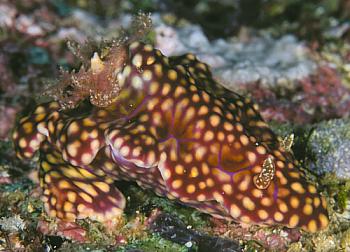Avoidance behavior in Ceratosoma sinuata
January 27, 2001
From: Mary Jane Adams

Hi Bill,
I found this Ceratosoma sinuata sitting on a rock at 22 meters in the Florida Islands in November, 2000. When I started shooting, it started rotating away from me. I had to keep moving around the rock to keep it's "face" in the picture. I also noticed this same apparent avoidance behavior with the Halgerda batangas I photographed a few days earlier. It was not moving until my strobes started firing, then it began to turn away from me.
The C. sinuata showed another behavior that I interpreted as agitation or possibly threat posturing. It was rapidly withdrawing and extending it's rhinophores. At first I thought it was a reflexive reaction to my strobes. The rhinophores withdraw immediately after each shot, but also every few seconds between shots.
Most nudibranchs I photograph appear totally unaware of me. These two, however definitely showed signs of trying to avoid the blast of intense light (and possibly heat?) from my stobes. Has anyone studied the reaction to noxious stimuli in sea slugs?
Best regards,
Mary Jane
divepng@yahoo.com
Adams, M.J., 2001 (Jan 27) Avoidance behavior in Ceratosoma sinuata. [Message in] Sea Slug Forum. Australian Museum, Sydney. Available from http://www.seaslugforum.net/find/3552Note added 30 April 2007: Until now on the Forum C. sinuata and C. flavicostata have been considerd forms of one species. See message #19854 where they and C. magnifica are considered separate species.
Dear Mary Jane,
Many sea slugs appear to be negatively phototactic, that is they move away from a light source. A major irritation when you are trying to draw them under a microscope. Since many opisthobranchs are active at night, apparently to avoid the attention of predators, a built-in behaviour which caused them to move away from light would cause them to move into shade (that is under rocks etc) and so into hiding. That is why cloudy overcast days are better for intertidal and tide-pool collecting them bright summer days.
Opisthobranch eyes seem only able to sense light and dark. This does allow them to sense shadows passing over them. I have certainly experienced animals withdrawing their rhinophores and gills when I have caused a shadow to pass over them. This is again probably a useful defence is a fish is about to have an investigatory nibble. I suspect the rapid withdrawal and extension of rhinophores may be a 'short circuit' in their nerve reflexes. I don't suppose their nervous system has evolved with bright strobes in mind.
The only systematic study of behaviour in sea slugs I know of is Eric Kandel's pioneering work on Sea Hares. He eexhaustively tested and described in minute detail their nervous system's response to all sorts of stimuli so that he had some base line data for his investigation into the workings of their primitive nervous system. I like to think his award this year of a Nobel Prize means that a sea slug worker has hit the big time. You'll find references to is two books, which I often refer to in an earlier message. That message also refers to Rhanor Gillette's website and lab where research on sea slug behaviour is also being conducted.
Bill Rudman
Related messages
-
Another misleading aquarium sale
From: Kevin Bott, November 25, 2009 -
Ceratosoma sinuatum feeding?
From: Mandi Woods, November 16, 2009 -
Ceratosoma sinuata from Reunion Is.
From: Sully Bachel, February 5, 2009 -
Ceratosoma sinuatum from East Timor
From: Brian Francisco, January 8, 2009 -
Ceratosoma sinuatum from the Philippines
From: Carlos Munda, April 7, 2008 -
Name changes in Ceratosoma
From: Bill Rudman, July 5, 2007 -
Ceratosoma sinuatum from southern Queensland, Australia
From: Gary Cobb, July 5, 2007 -
Ceratosoma sinuata from Komodo area
From: Marli Wakeling, June 1, 2007 -
Re: Ceratosoma sinuata from Clovelly, Sydney
From: Salvador C Tan, May 1, 2007 -
Ceratosoma sinuata from Sulawesi
From: Mary Jane Adams , December 21, 2002 -
Ceratosoma sinuata from Hawaii
From: Andy Woerner, May 27, 2001 -
Ceratosoma sinuata from Clovelly, Sydney
From: Donata P. & Akos L., October 24, 2000 -
Re: Ceratosoma sinuata from the Solomon Ids
From: Mary Jane Adams, October 24, 2000 -
Another Ceratosoma sinuata from Solomons
From: Buce Potter, October 24, 2000 -
Three versions of Ceratosoma sinuata
From: Scott Johnson, October 23, 2000 -
Ceratosoma sinuata from the Solomon Ids
From: Bruce Potter, October 19, 2000 -
Ceratosoma sinuata? from Thailand
From: Narongpon Sittithaweepat, May 11, 2000 -
Ceratosoma sinuata from Okinawa, Japan
From: Kazuko Matsuda, February 13, 2000 -
Two juveniles of 'Miamira-group' from Okinawa
From: Kazuko Matsuda, February 2, 2000 -
Re: Ceratosoma (=Miamira) sinuata from Sydney
From: Erik Schloegl, October 23, 1999 -
Ceratosoma (=Miamira) sinuata from Maldives
From: E. Koehler, October 19, 1999 -
Ceratosoma sinuata Fact Sheet
From: Bill Rudman, October 18, 1999
